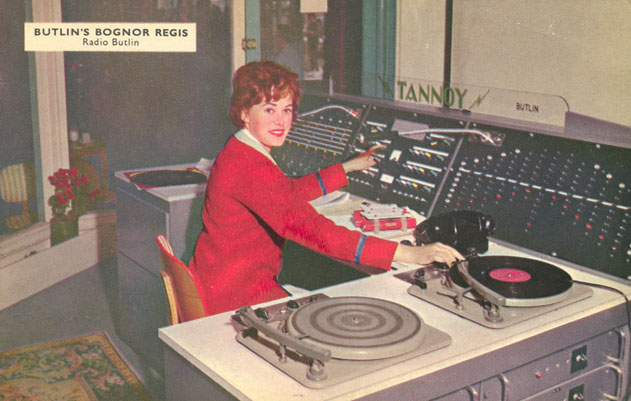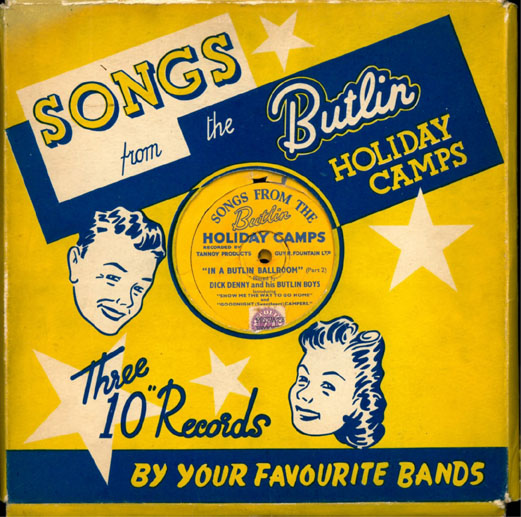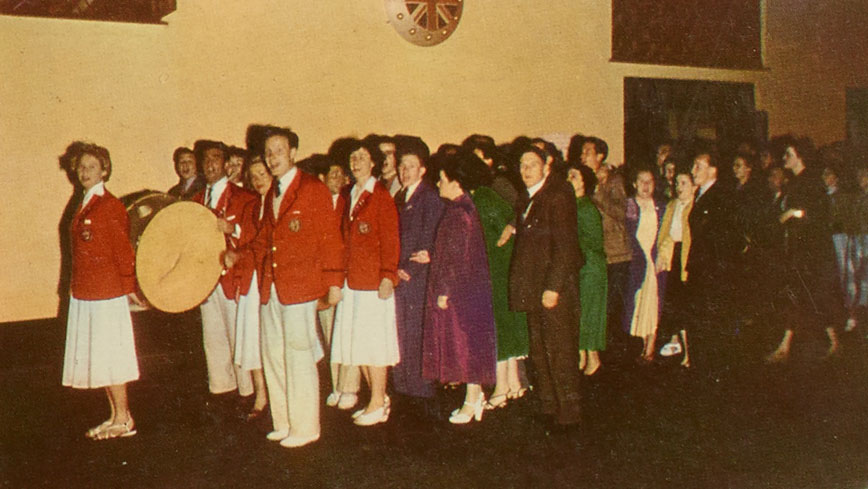The Sights and Sounds of Butlin’s
The Butlin’s Heritage Collection held at the History of Advertising Trust (HAT) features a range of audio-visual material in various formats such as 16mm film reels, Betacam tapes, audio cassettes and gramophone records. In order to effectively preserve and utilise this material we have been repackaging, cataloguing and digitising it, a project which is scheduled for completion in 2020.
The collection includes copies of some of the most iconic Butlin’s advertising campaigns. In the fifties and sixties the
Butlin’s by the Sea series of commercials grabbed attention with a cheery jingle and colourful design and
People and Butlin’s emphasised the wide appeal of the brand by highlighting lovers of Butlin’s holidays from contrasting professional backgrounds (everything from an architect, air hostess and accountant to an optician, film director and fashion designer).
During the same period several information films were created for cinema audiences focusing on elements of the Butlin’s experience (not commercials but produced for publicity purposes). Examples held include the British Pathe Fun and Games series illustrating the enjoyment and community spirit of a Butlin’s holiday with activities such as makeshift Roman chariot racing at Filey, traditional Philippine folk dancing at Ayr (albeit led by local Wendy Edwards) and an unconventional swimming gala at Clacton.
The seventies Butlinland campaigns, created after the Rank Organisation takeover of Butlin’s, are notable for the replacement of the
Butlin’s by the Sea jingle with tunes such as Roger Greenaway’s
Butlinland! and Mike D’Arbo’s
Butlinland is Freedomland. In the 1980’s Butlin’s advertising included the riotous
If you like a bit of this and quite a lot of that, Happy Families, a mixture of animation and live-action and the dramatic
Exploding the Myth, which promoted the new Holiday Worlds by blowing up the old chalets and dining hall at Bognor. In the 2000s
Crying Kids showed inconsolable children weeping because their parents were taking them to Florida and Lapland rather than Butlin’s.
 Postcard of a female Redcoat presenting Radio Butlin at Bognor Regis, c1960s
Postcard of a female Redcoat presenting Radio Butlin at Bognor Regis, c1960s
B/6/3/2/1/5/11
The earliest films held are copies of amateur productions created by visitors to Butlin’s. One short feature entitled
Happy Memories of Butlin's Holiday Camp shows the first resort at Skegness in 1937, a year after it opened, including footage of various competitions and fun activities. The earliest colour film is
Sunny Clacton-on-Sea made in 1939 by father and son William and K.O. King just weeks before the outbreak of the Second World War. It is nevertheless filled with happy, smiling holidaymakers, with the only hint of impending global conflict a Clacton Carnival procession float promoting world peace.
Music forms a key part of Butlin’s history and this is reflected in the collection in the form of shellac and vinyl records and audio cassettes. From 1946 each Butlin’s day began around 7.30am with music piped into chalets via Tannoy (perhaps Tolchard Evans and his Singing piano, Sleepy Shores by Johnny Pearson and his orchestra or Zip-a-dee-doo-dah by the Ray Coniff Singers) along with the voice of a cheerful Redcoat. Some holidaymakers welcomed this start to the day, known as the Wakey Wakey call, as it helped them get up in time for their appropriate breakfast sitting but others arrived armed with wire cutters to sabotage the speakers and engineer themselves a lie-in. Along with examples of the various tunes used we hold a BBC Radio 4 recording of the final ‘Wakey, Wakey’ played at Butlin’s Ayr on 14 Sep 1979 after which Billy Butlin’s son Bobby (by then Butlin’s Managing Director following his father’s retirement in 1968) is heard ceremonially breaking the records with an anvil to cheers from the crowd.
 Album cover for Songs from the Butlin Holiday Camps, 1947
Album cover for Songs from the Butlin Holiday Camps, 1947
B/13/6/10
From very early on Butlin’s music was commercially available and copies survive including song and dance numbers by Billy Thorburn and his band recorded at Clacton, 1939;
Carol Singing at Kingsway Hall by the Butlin’s Choral Society, who from the 1950’s sang at charity functions and the Butlin’s Sunday night cabaret; souvenir albums of the Butlin’s Barry Island
Festival of the Sixties, which pioneered the concept of artists from bygone generations reforming to play to nostalgic audiences and the soundtrack for the 60th anniversary musical
The Butlin’s Story (1996), recorded at the London Palladium starring Alvin Stardust as Billy Butlin.
 Postcard of Redcoats leading holiday-makers to Penny on the drum at Butlin's, 1950s B/6/1/1/10/2/11
Postcard of Redcoats leading holiday-makers to Penny on the drum at Butlin's, 1950s B/6/1/1/10/2/11
The tune
Penny on the Drum by Stanley Holloway was a notable part of Butlin’s history as in the early days it helped clear the bars at closing time. Inspired by a film about chain-gang workers, one night Norman Bradford, who was the first Redcoat, put his hands on fellow Redcoat Frank Cusworth’s shoulders and began shuffling across the floor to the tune. Campers joined the line, the bars emptied and a nightly tradition was born. Other musical standards for the evening big bands included
Now We're at Butlin's by Charles Amer,
Butlin Buddies by Al Fried,
The Butlin Waltz by Eric Winstone and In a
Butlin Ballroom by Dick Denny and his Butlin Boys. Toe-tapping tunes which inspired much dancing and many communal sing-alongs usually culminating in a rendition of Goodnight campers to finish the night.
Butlin’s, founded by Sir William E. (Billy) Butlin in 1936, have commissioned HAT to manage, catalogue and activate the Butlin’s Heritage Collection. HAT, based at Raveningham in Norfolk, is the largest archive of British advertising in the world. The collections range in date from 1800-today and feature many of the most iconic ads of the past.
If you would like to visit the archive as a researcher or as part of a group tour please click here or contact us directly: enquiries@hatads.org.uk / 01508 548623.
Mark Pitchforth
History of Advertising Trust
« All News Articles